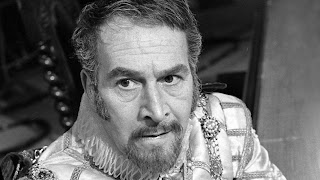Well, the recons keep coming. This is the first story I have
had to review solely on its reconstruction. I’m not sure if I can do them all
this way when some missing stories are a full six parts. However, I did get
through ‘The Massacre’, the third and final Doctor Who story written by John
Lucarotti.
This story feels like no other story so far. It’s written in
a very adult way, and apparently mostly by script editor Donald Tosh. Episode
Two had a huge rewrite because William Hartnell was given a holiday with no
notice given to Lucarotti. I was told it is famous for Hartnell’s performance
as a second character, The Abbot of Amboise, however for those who haven’t seen
the recon I must set something straight, the Abbot is hardly in the thing! He
has a couple of scenes in episode three, appears for a fleeting moment at the
end of episode one, and as a pre-filmed insert in episode two as Steven watches
him chatting from afar.
This is a VERY straight and serious story, and after twelve
Dalek episodes the audience must have been a bit shocked really. It’s an
historical story where the Doctor and his companion are very much at the
periphery of the action and story. We watch as history takes place.
16th century France was clearly a very dark place
and time to live. The events of ‘The Massacre’ detail the lead up to a massacre
sanctioned by King Charles IX and pressed for by his mother of the Huguenots –
protestants, because of a fear that they would take power in France. Barry
Justice’s King Charles is played as being quite mad, and indeed there are many
interesting characters in this story. It’s a very good piece of historical
drama.
However, as a Doctor Who story it is decidedly odd. The
action is somewhat followed through the eyes of Steven, as the Doctor doesn’t
appear from half way through episode one to midway through episode four. We
have the Abbot as the Doctor’s doppelganger, but this is not used effectively
other than to suggest to Steven that the Doctor is dead when he sees the
Abbot’s body in episode three. We never see the Doctor and the Abbot together,
hard to do in the 60s but not impossible.
Steven is oblivious, as was this viewer, to the actual
history of the story. He didn’t know the characters or that it was all leading
to the massacre of over 10,000 Huguenots. If you removed the Doctor and Steven
from the story you would have a fine piece of historical drama.
Episode Four is even odder than the first three. The Doctor
reappears and for some reason has no qualms about letting Anne Chaplet, new friend
to Steven and Huguenot back onto the streets hours before the massacre takes
place. He DID know what was about to happen. The Doctor comes to Paris, chats
to scientist Presslin, disappears, reappears and takes Steven back to the
TARDIS. That’s all he does in four parts.
Steven is fed up, and I guess this is another lesson from
Doctor Who about not being able to interfere in history. Then they land on
Wimbledon common, and a Miss Dorothea Chaplet runs on board the TARDIS. She
wants to call for help, but when Steven spies policemen heading in the
direction of the TARDIS, the Doctor takes off with Dorothea, or ‘Dodo’ on
board. She says she hasn’t any parents and that’s she’s fine with being whipped
off into time and space.
It’s all a bit ‘make-do’ really. We have no background for
Dodo, no proper introduction. Perhaps in the next story (with four fully
existing parts!) we’ll learn a bit? The final episode does include a wonderful
sad speech by the Doctor about everybody leaving him. Hartnell is excellent in
this story, as is the entire cast. Steven is very strong, the guest cast
perfect.
It doesn’t feel like any other Doctor Who episode thus far.
I can’t imagine it’s one that children would enjoy, and the viewing figures did
taper off after episode one. It’s brave, confronting, sad and hopeful at the
same time. It shows that Doctor Who can be about anything I guess.
8/10






No comments:
Post a Comment